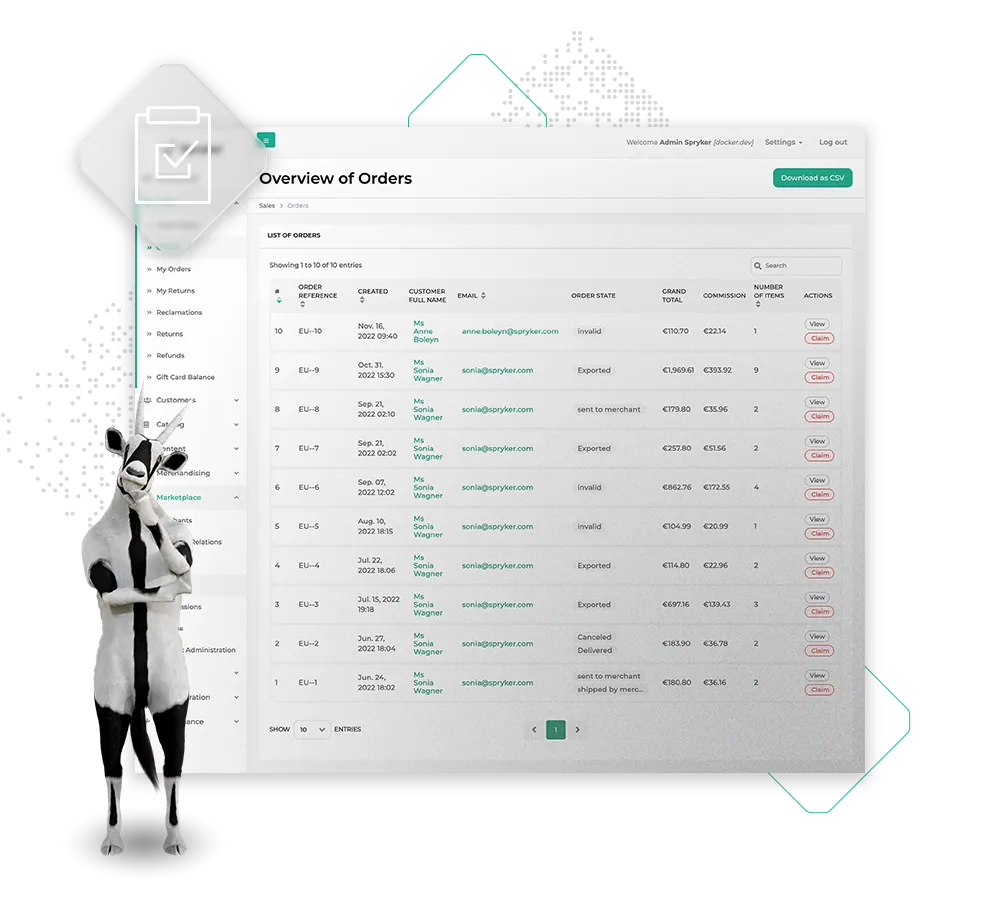Cost Efficiency Through Order Process Automation
How digitization can significantly cut costs while enabling your business to keep up with the growing demands of the B2B digital purchasing process.Status Quo
Owing to the shift from physical to digital, tasks and activities that historically relied on labor have become technology-based–eliminating human error and allowing employees to focus more on high-value tasks.
In the B2B world, manual order processes are no longer sufficient. Customers expect smooth and fast order processes regardless of the complexity of the goods or services. New technologies, including automation, telemetrics, machine learning, and service platforms, are required to make operations more efficient.
Additionally, automating various process elements ensures consistency, efficient inventory control, easy order management, storage space optimization, and increased productivity.
Regardless of whether the budget for technology increases, overall expenses should decrease because investing in technology saves costs while boosting productivity, and accelerating growth.Challenges Of The B2B Order Process
- Increased risk due to human error.
- Lack of transparency resulting in inconsistent data and inaccurate analysis or reports.
- Poor customer experience due to slow response and waiting times as well as a higher likelihood of order errors.
- Reduced competitiveness due to a lack of easy digital solutions.
- Complicated payment processes accompanied by countless paperwork.
- Numerous decision makers causing bottlenecks in the buying process.
- Complex products that require proof devices to encourage the prospects to buy.

How Order Process Automation Boosts Cost Efficiency
The cost-effectiveness of order process automation can be increased in various ways. Numerous options may be considered, depending on the product or service and the complexity of the ordering process. However, the quantity of manual labor involved in the actual order process is the one component that has the most significant influence on the cost of the order management process and consequently also its efficiency. Therefore, it is crucial to minimize manual effort on the buy-and-sell side where possible.
According to a 2019 Gartner survey, 77 percent of B2B buyers said their most recent purchase was very complex or difficult. In light of this, businesses are under immense pressure to change their strategic priorities to meet the demands of digital purchasing. They need innovative solutions and more effective ways to address buyers' challenges.
Fast forward to 2022, McKinsey insights reveal that B2B buyers prefer a combination of remote human contact (video conference or phone), digital self-service (e-commerce), and in-person interactions. The same report states that the number of channels used by B2B decision-makers has doubled since 2016, and businesses that offer more purchasing channels are more likely to increase their market share.
- Displaying product availability online
- Enabling purchases across multiple channels
- Real-time customer support
- A seamless omnichannel experience
On the practical side, businesses on the sell side (i.e. the B2B manufacturer), require multiple digital features to efficiently track order processing from B2B, B2C, or marketplaces, ensuring quick fulfillment and ultimately saving costs.
How each order process stage is accelerated by Spryker features
- State Machine allows the simple automation of any business process regardless of the complexity level. It enables non-technical stakeholders to manage the process mapping with little to no technical knowledge requirements. State machines are essential ‘business process models’ which create a standard way of configuring and executing business processes such as payment, shipping, and more to ensure uniformity. They support all stages of the buying/order process.
- Self-service digitized quoting empowers customers to quickly and effectively request and update quotations or estimates. This feature is useful during shortlisting, solution fit, and negotiation.
- Configurator opens up the opportunity to personalize and optimize products and services together with a virtual assistant. This feature is handy from the analysis, shortlist, solution-fit & negotiation, through to the agreement stage.
- (Automated) re-order prompts a request for more supplies before they run out. This feature is useful for recurring orders and for maintenance purposes. Depending on the frequency of orders, this can be a game-changer in increasing cost efficiency. Simultaneously it is a great tool to create a lock-in effect with the buy-side.
Less Manual Interaction & Reduced Costs
- Reduction in processing costs due to little to no “manual” interaction
- Reduction of Human Error
- Collection of valuable data and insights
- Streamlined order processing
- Easy conversion of self-service requests into digital orders
- Higher conversion rates through recurring orders
- Real-time customer support
- A seamless omnichannel experience
- Increased Customer Satisfaction and Customer Lifetime Value

Spryker Capabilities
- SCCOS
- Order Management System (OMS) Matrix
- State Machine Modelling
- Reorder
- Configurable bundles
- Quotation and Offer Management
Enabling Services
- Calibration session
- Customer journey analysis
- Digitization mapping
- Operating model coaching
- Process design workshop
Technology Partner
- Fareye (Delivery Platform)
- Easypost (3rd Party Logistics)
- Paqato GmbH (Post Purchase Experience)
Sonepar
Simple and fast online product configuration of electrical products and solutions.
Sonepar's product catalog helps customers search, find and individually configure low-voltage products. Leveraging Spryker’s Configurator feature, "e-Configure" combines engineering and product expertise for user guidance, enabling intuitive navigation through the product portfolio. The feature offers recommendations during the selection process to make the process as efficient as possible, including search filtering options based on multiple criteria. Finally, with the Quotation and Offer Management feature, customers can easily customize existing lists or create new quote requests directly to their personal Sonepar sales contact.
SLV
Customizable lighting solutions that combine design and technology to provide versatility with minimum effort.
SLV customers go through an online product configuration process where they can select the product, basis, and accessories. The entire selection and configuration process is online and initiated solely by the customer. SLV’s system guides the user at every step including providing suggestions for compatible accessories and additional buying advice along the way. When the process is complete, it creates an order summary, which is forwarded to a sales representative who uses the data to generate an instant quote. SLV is supported by Spryker Cloud Commerce OS, and features such as Configurator and Quotation and Offer Management
Sourceability
A scalable digital marketplace connecting Sourceability’s electric components, services, and data to the world.
Sourcengine applied the right mix of deep industry knowledge with a technology-driven customer-centric approach to create a marketplace targeting an entire sector. Enabling customers and merchants to digitally buy-and-sell worldwide, without a middleman, is opening new doors for electronic component trade and industry-wide product transparency. Backed by Spryker Cloud Commerce OS, Sourcengine is a leading B2B marketplace for the electronic components supply chain. Each component created in the industry has been indexed to be searchable and purchasable for professional buyers on the marketplace. Unlike the more standardized experience customers might expect from B2C-oriented commerce, Sourcengine heavily invested in tools and functionalities to serve the specific needs of B2B buyers. Quotengine for example is a cutting-edge BOM management and enterprise quoting solution, providing immediate access to prices and availability from more than 3,500 vendors. From a single simple interface, buyers can instantly purchase parts or submit RFQs to have them procured by Sourceability’s international sourcing team.
About Spryker
Spryker is the leading global composable commerce platform for enterprises with sophisticated business models to enable growth, innovation, and differentiation. Designed specifically for sophisticated transactional businesses, Spryker’s easy-to-use, headless, API-first model offers a best-of-breed approach that provides businesses the flexibility to adapt, scale, and quickly go to market while facilitating faster time-to-value throughout their digital transformation journey. As a global platform leader for B2B and B2C Enterprise Marketplaces, IoT Commerce, and Unified Commerce, Spryker has empowered 150+ global enterprise customers worldwide and is trusted by brands such as ALDI, Siemens, ZF Friedrichshafen, and Ricoh. Spryker is a privately held technology company headquartered in Berlin and New York backed by world class investors such as TCV, One Peak, Project A, Cherry Ventures, and Maverick Capital. Learn more at spryker.com.